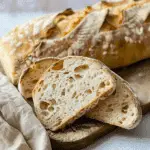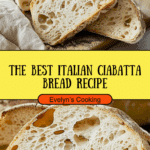Description
A rustic Italian-style bread with a crisp crust and airy, chewy interior, made at home from simple ingredients.
Ingredients
- 500 g bread flour (or strong white flour)
- 400 ml water (room temperature)
- 2 tsp salt
- ½ tsp instant yeast
- Olive oil (for greasing bowl or drizzling, optional)
Instructions
- In a large bowl, mix flour, yeast, and water until just combined into a sticky, shaggy dough.
- Let the dough rest, uncovered, for about 20–30 minutes (autolyse), so the flour hydrates.
- Add salt and gently fold it in, trying not to deflate the dough.
- Cover the bowl and let the dough ferment (bulk rise) for about 1 to 1½ hours, performing gentle stretch-and-folds every 30 minutes (lift a side of dough and fold over, turning bowl).
- After bulk fermentation, transfer to a well‑floured surface. Gently shape into a rough rectangle or “slipper” shape, trying to preserve air bubbles.
- Place the shaped loaves (or rolls) on parchment‑lined baking sheets, dusting lightly with flour. Cover and let proof for 45–60 minutes (or until puffy).
- Preheat oven to 220 °C (425 °F). To get a crusty exterior, add steam (e.g. a tray of ice or water in the oven bottom) or spray water inside the oven before baking.
- Slide the loaves (on parchment) into oven and bake for 20–30 minutes, until golden brown and hollow-sounding when tapped on the bottom.
- Remove from oven and cool on a rack for 30–45 minutes before slicing (to allow structure to set).
Notes
- Because ciabatta dough is very wet (high hydration), it’s normal for it to be sticky — use plenty of flour on work surfaces and parchment paper.
- Don’t rush shaping — be gentle so you don’t collapse too much of the interior air.
- Steam at the start of baking helps form a crisp crust.
- Letting the bread cool adequately before slicing gives better texture and avoids a gummy interior.
- You can retard (chill) the dough in the fridge for longer fermentation to build more flavor.
Nutrition
- Serving Size: 1 slice (approx)
- Calories: ≈ 200 kcal
- Sugar: ≈ 0.5 g
- Sodium: ≈ 300 mg
- Fat: ≈ 1 g
- Saturated Fat: ≈ 0.2 g
- Unsaturated Fat: ≈ 0.8 g
- Trans Fat: 0 g
- Carbohydrates: ≈ 42 g
- Fiber: ≈ 2 g
- Protein: ≈ 7 g
- Cholesterol: 0 mg

